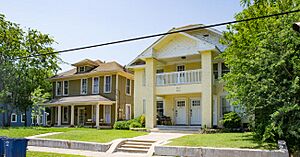Peak's Suburban Addition, Dallas facts for kids
Quick facts for kids
Peak's Suburban Addition
|
|
|---|---|
|
Neighborhood
|
|

Country estates built in the second half of the 19th century
|
|
| Country | United States of America |
| State | Texas |
| County | Dallas County |
| City | Dallas |
| Time zone | UTC-6:00 (CST) |
| • Summer (DST) | UTC-5:00 (CDT) |
Peak's Suburban Addition is a really old and special neighborhood in Dallas, Texas, in the United States. It's officially recognized as a historic district by the City of Dallas. This area is located in East Dallas, with its borders roughly defined by streets like N. Fitzhugh, Sycamore, Peak, Haskell, and Worth. This neighborhood is actually the oldest planned community and residential area in East Dallas!
Contents
How Peak's Suburban Addition Began
The land where Peak's Suburban Addition now stands was once a large farm owned by a man named Jefferson Peak. He was a soldier who fought in the Mexican–American War in 1846. After the war, he remembered how much he liked the area.
In 1855, Jefferson Peak moved to Dallas. He bought land and built the very first brick house in Dallas at the corner of Worth and Peak streets. Many people call him the "father of East Dallas" because he helped the area grow so much.
Some people even say this area is older than the city of Dallas itself. Dallas officially became a city in February 1856, just after Peak built his home.
Growing Dallas: From Farms to Homes
After the American Civil War, other big landowners, like William H. Gaston, also bought land in the area. Gaston was a former soldier who bought 400 acres along what is now Swiss Avenue.
Gaston helped bring railroads and other businesses to East Dallas. This led to many more people wanting to live there, causing a shortage of homes. Because of this, Jefferson Peak and others started dividing their large land holdings into smaller plots to sell for houses.
Before 1882, when East Dallas became its own city, most of the activity in the area was related to farming.
The Peak Family's Land Division
Jefferson Peak started dividing his family's land in 1874, creating the first sections along Ross Avenue.
Then, in 1879, Jefferson and his son, Junius Peak, divided their family farm into 16 blocks. They started selling these as "Peak's Suburban Addition." They even named some of the streets after their children: Worth, Carroll, Junius, Victor, and Flora. You can still find these streets crossing between different historic districts today.
Jefferson Peak originally owned a huge amount of land. It stretched from Elm Street to Capital Street and included Carroll and Haskell Avenues.
After Jefferson Peak passed away in 1885, his son Junius continued to divide and sell off the family's large land. The land around the original Peak family home was sold as "Peak's Addition" starting in 1897. This really helped new homes get built in East Dallas.
Jefferson Peak's son-in-law, Thomas Field, was also a very active real estate developer in East Dallas during the 1880s and 1890s. His company, Field and Field Real Estate, helped manage the sale of many large pieces of land in East Dallas. He lived on Peak Avenue.
How Streetcars Helped the Neighborhood Grow
The arrival of streetcar lines in East Dallas was a huge deal for the development of Peak's Suburban Addition. Between 1887 and 1893, streetcars started running, making it much easier for people to travel.
The "Bryan Line" was one of the main streetcar routes that connected the northern parts of East Dallas to the city's main business area. This made living in Peak's Suburban Addition very appealing because people could easily get to work and other places in Dallas.
Amazing Architecture
Peak's Suburban Addition is like an outdoor museum of house styles! You can see homes built from the 1890s all the way to the 1930s.
The neighborhood has many different architectural styles, including:
- Late Queen Anne: These homes often have towers, turrets, and decorative details.
- Tudor Revival: Look for steep roofs, decorative half-timbering, and tall, narrow windows.
- Classical Revival: These houses might have columns, grand entrances, and a balanced, formal look.
- Mission Revival: You might spot smooth stucco walls, red tile roofs, and arched openings.
- Victorian: This is a broad style, but these homes often have lots of decorative trim, varied textures, and complex shapes.
- Craftsman Bungalows: These are usually smaller, cozy homes with wide porches, exposed rafters, and natural materials.
Peak's Suburban also has some "streetcar apartments" from the 1920s and 1930s. These were built near streetcar lines for easy commuting. In fact, this neighborhood has the highest number of Victorian homes in all of Dallas!

